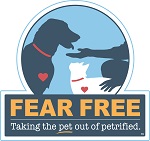So the veterinarian has told you your dog should lose some weight. Is it really that big of a deal? After all, he/she looks cute a little pudgy and seems happy. Everyone in the family loves giving treats and your dog begs all the time, so obviously is hungry, right? While pudgy pets get all sorts of cute nicknames and have learned that food equals attention, the extra weight isn’t doing your dog any favors. Dogs that are overweight are much more prone to all sorts of health issues including arthritis, high blood pressure, heart disease and respiratory issues, type 2 diabetes, chronic inflammation and even some forms of cancer (especially intra-abdominal). It is known that overweight/obese dogs tend to live shorter lives. It is estimated that at least 65% of dogs are overweight or obese. Since we are so used to seeing overweight pets, it can be difficult for pet owners to recognize what a healthy body condition looks like.
Once you have decided to help your dog lose weight, where do you start? A good place to start is to figure out how much your dog is currently eating on a daily basis. If you aren’t measuring food and just leaving it out free choice, you will need to start measuring. If several people in your family are giving treats or table scraps throughout the day, this can easily add on many more calories than you realize. It is imperative to start by getting an idea of how much your dog is currently eating. If free feeding, measure the amount of food in the bowl at the beginning and 24 hours later over several days to get an average of how many cups of food your dogs consumes each day. If you just dump food in or use a random “scoop”, start using measuring cups to determine the total number of cups eaten each day. To try to get a handle on the amount of treats and extras your dogs gets daily, put a bowl on the counter in a centralized location and ask everyone giving treats to put an equal amount of each treat or table scrap in that bowl whenever they give the dog something. This requires everyone to be on board and honest and should be done for several days to get a realistic evaluation of the true amount of “extras” being given. Many times, people are quite surprised how much is truly being given on the side. It can add up fast!
Figuring out the total number of calories your dog is eating each day is the next step. You will need to look up the calories per cup of the dog food you are feeding. This can require a little bit of digging on the internet or even calling the company if the calorie content is not listed on the bag. Calorie content of various dog foods can vary widely. On average different brands and formulations can range between 325 to 600 calories per cup! Make sure to look up the calorie content of dog treats you are giving and try to estimate calorie content of any other extras that are being fed. The calorie content in these can vary widely as well. For instance, Milkbones have between 20 and 125 calories per biscuit depending on the size, whereas Pupcorn treats have less than 4 calories per treat. Choosing lower calorie treats can make a huge difference in the total number of calories your dog eats each day. Some dogs eat more calories in treats and table foods than they do in actual dog food!
Once you have an idea of how many calories your dog is realistically eating per day, it is time to find ways to reduce calories and also to figure out how much your dog needs to lose. Your veterinarian will be the best source of information for a healthy weight goal for your dog. A healthy weight will depend on your dog’s breed, age, build and other factors. Just like we can’t say that all people should weigh a certain amount, we cannot say that all Labradors should weigh a certain amount. It is even trickier with mixed breed dogs. Once you have determined what your dog’s weight should be and how much he/she needs to lose, you can start making a plan. A healthy weight loss goal is to lose 3-5% of body weight per month.
Ways to reduce calories are many. Switching to a lower calorie food can be an easy way to reduce calorie intake without necessarily reducing the amount fed. Most brands have a “light” or “reduced calorie” version that can be easily switched to or you may decide to switch brands entirely. Food switches should always be made gradually over a 5-10 day period to avoid GI upset. Make sure to calculate how many calories are being eliminated by your switch by determining the calorie content per cup. For example, for a dog that eats 2 cups of food per day, reducing the calories per cup by 50 calories, will result in 100 less calories per day. Next, evaluate treats and table foods being given. You can still give treats, but finding ways to reduce the calories being given can go a long way with weight loss. Breaking large treats into many smaller pieces can help as well as finding lower calorie options. Most dogs will appreciate treats of Cheerios, green beans, apple pieces, plain popcorn or other fruits and veggies versus higher calorie treats or table foods. Getting everyone in the family on board is extremely important. If one person continues to give high calorie, frequent “extras” it can really sabotage your pet’s weight loss goals.
Increased exercise can help to burn calories and decrease boredom that leads to begging. If your pet is out of shape, work up slowly with short sessions that you gradually increase. When going for walks, make sure that more walking is being done then stopping and sniffing. Slowly increase the distance as your pet builds stamina. If your dog likes to fetch, playing ball or tossing sticks is great exercise. If your dog likes to swim, find places to take your dog to allow them to swim to burn some calories. Hide and seek with a portion of your dog’s regular kibble allotment is another way to encourage movement and add some interest to your dog’s day. When your pet begs for treats, offer petting or activity instead. Many times, begging is a form of getting attention and a way to alleviate boredom and has become a habit. If your dog is not used to meal feeding, it can take some time for your pet to get used to. Put the measured amount of food out for 15-30 minutes and pick it up once that time period is up. It shouldn’t take too long for your dog to be hungry enough to finish each meal when offered and get used to the idea that the food is not available 24/7.
A good source of information on weight loss, including information on how many calories your dog should be fed can be found on the website – petobesityprevention.org/weight-loss-dogs. Your veterinarian can also calculate your pet’s calorie needs for weight loss for you and help you to figure out what a healthy weight for your dog is. If your dog does not lose weight within 90 days of starting a weight loss program, you should re-evaluate and change something.
Just like for us, weight loss takes some commitment and a plan. Bad habits need to be changed into healthier habits which can take time. If you make a reasonable plan and get the family on board it can be a fun challenge for everyone. Write down your plan and make sure to get your pet weighed at least monthly to see if your plan is working. If it isn’t, evaluate what needs to be tweaked to meet your goals. Your veterinary team is always happy to help, so reach out for ideas and information when needed. We all want your pet to be happy and comfortable and live a long and healthy life!




